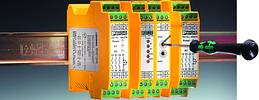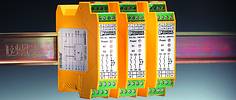
The goal of safety technology for machinery and facilities is to prevent industrial accidents. These can be caused by machine failure, faulty operation or bypassing safety mechanisms. Here, appropriate safety installations and adhering to European machinery legislation as laid down in the EC machinery directive 98/37/EC can help to solve the problem.
Safety regulations
Product or machine manufacturers themselves declare conformity to EN harmonised standards. If products bear the CE mark, then the safety requirements of the applicable EC guidelines have been met and an evaluation of conformity has taken place. Therefore, the CE mark is an administrative mark for the regulatory authorities, but it is not a sign of quality or origin and does not even guarantee standards conformity.
Improving safety
Strategies for improving the safety of machinery and facilities are set out in the EN 292 basic concepts standard. Accident prevention starts with inspecting the design of the machine. This includes ergonomic considerations to ensure a user-friendly operator's console, the avoidance of sharp edges and corners in the operating environment, selection of appropriate materials when building the machine as well as insulation against contact with electrically conducting parts. If there is no way to further reduce potential danger situations, then appropriate safety measures must be implemented (see Figure 1).

Categories
Controllers that are responsible for the safety of the machine or installation are grouped into five risk categories. These categories are detailed in harmonised standard EN 954-1 and are classified according to risk level. For example, if a fault occurs in a single-channel design for a category-two safety door monitor, this may lead to a protection loss. This loss can be prevented if the fault is detected during an inspection. This inspection can be described in operation instructions or may be performed by safety switching devices. Category four - the highest safety level - requires all errors to be detected before or during an attempt to use the facility. The so-called C standards assist manufacturers and operators in placing machines and facilities in the appropriate categories. These product norms exist for many types of machinery and describe the safety-relevant aspects of the installation. If there are no relevant C standards or if they do not specify a safety category, then the risk graph from the EN 954-1 standard helps determine the category.
Selecting components
To prevent danger situations, safety cut-out components such as emergency cut-out buttons and safety limit switches are used. Even though these conventionally wired switching elements meet the safety requirements, they cannot ensure fault-free signal evaluation and wiring. To ensure 1-fault safety, the properties of the installed components and the wiring must undergo a close evaluation. Safety relay combinations are implemented for reliable signal evaluation and monitoring. These modules carry out cyclical monitoring of the circuit, will detect short circuits, prevent restarts and will lock machinery if power is switched back on.
Force-guided contacts
Relays with force-guided contacts are the heart of safety relay combinations. The requirements of these relays are described in European standard EN 50205. These contacts provide correct switching state feedback even when there is a fault. For example, if a closed contact has welded shut and will no longer open, the non-equivalent contact can report this condition through the forced guidance. (European Standard EN-50205 - 3.1 dictates that at least 1 N.O. contact and 1 N.C. contact in a set must be mechanically linked together, so that it is impossible for N.O. and N.C. contacts to be closed at the same time - ed) The safety relay combination's combinational logic evaluates the status and puts the system in a safe condition and/or prevents a restart.
Safe isolation
The redundant contacts used are DC-isolated from each other with reinforced insulation, enabling safe switching of different potentials. As an example, think of a process that is controlled with a 230 V mains voltage and whose switching states are reported to the controller with 24 V. In the event of an insulation fault within the switching devices, the basic insulation could be lost. This could bring about a dangerous situation and 1-fault safety would no longer be provided. Phoenix Contact's PSR safety relays provide reinforced or double insulation.
Existing wiring
If the safety relay combination has to be replaced during servicing, it is important that the safety-relevant parts of the installation function properly afterwards as they did initially. If modules with hardwired terminals are used, it can happen that not all the wires are reconnected correctly. If two cables were swapped, then two faults would be lurking in the wiring and might well go unnoticed at first. An error will not occur until the next request is made for the system concerned. Coded, pluggable terminals help to avoid this kind of problem.
Safety relays
At the 2002 Hanover Fair, Phoenix Contact presented its entire safety relay product range. These components enable monitoring for emergency cut-out and safety door circuits as well as two-hand controls. All connections are pluggable and coded. With a compact and space-saving design, the safety relay modules also feature reinforced insulation between input/output and between release and signalling circuits. Depending on the application, one- or two-channel safety circuit control can be used with or without short-circuit detection. These modules meet the requirements of EN 954-1 category 4 and can be used for stop category 0/1 as defined by EN 60204.
Emergency cut-out/safety door
For monitoring emergency cut-out and safety door circuits, the safety relays offer up to eight release current paths and one signalling path. Drop-out delay contacts complying with safety category four according to standard EN 954-1 are adjustable up to 600 s and are suitable for safe time functions (see Figure 2). They offer comprehensive diagnostics capabilities for internal and external peripheral devices. Modules with manual activation also perform a functionality test on the connected start button. This ensures reliable malfunction detection.

Two-hand
The two-hand control modules test the simultaneity of both inputs with respect to a period of less than 0,5 s. This also enables the implementation of applications in accordance with EN 574 type IIIC. The modules also meet safety category 4 for controlling, isolating protective installations. For this purpose, two release current paths and one signalling current path are available with safe insulation in a module 22,5 mm wide. By using corresponding expansion modules it is possible to safely connect up to six release current paths (see Figure 3).

Thomas Hüttemeier is a certified engineer in the field of automation technology and works in the Interface department of Phoenix Contact's product marketing division in Blomberg.
| Tel: | +27 11 801 8200 |
| Email: | [email protected] |
| www: | www.phoenixcontact.co.za |
| Articles: | More information and articles about Phoenix Contact |

© Technews Publishing (Pty) Ltd | All Rights Reserved